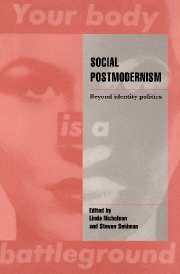Book contents
- Frontmatter
- Contents
- Notes on contributors
- Acknowledgements
- Introduction
- Part I Critiques of identity
- 1 Interpreting gender
- 2 Feminist encounters: locating the politics of experience
- 3 Postcolonial criticism and Indian historiography
- Part II Critiques of the deconstruction of identity
- Part III Postmodern approaches to the social
- Part IV Postmodern approaches to the political
1 - Interpreting gender
Published online by Cambridge University Press: 29 October 2009
- Frontmatter
- Contents
- Notes on contributors
- Acknowledgements
- Introduction
- Part I Critiques of identity
- 1 Interpreting gender
- 2 Feminist encounters: locating the politics of experience
- 3 Postcolonial criticism and Indian historiography
- Part II Critiques of the deconstruction of identity
- Part III Postmodern approaches to the social
- Part IV Postmodern approaches to the political
Summary
“Gender” is a strange word within feminism. While many of us assume it has a clear and commonly understood meaning, it is actually used in at least two very different and, indeed, somewhat contradictory ways. On the one hand, “gender” was developed and is still often used as a contrast term to “sex,” to depict that which is socially constructed as opposed to that which is biologically given. On this usage, “gender” is typically thought to refer to personality traits and behavior in distinction from the body. Here, gender and sex are understood as distinct. On the other hand, “gender” has increasingly become used to refer to any social construction having to do with the male/female distinction, including those constructions that separate “female” bodies from “male” bodies. This latter usage emerged when many came to realize that society shapes not only personality and behavior; it also shapes the ways in which the body appears. But if the body is itself always seen through social interpretation, then sex is not something that is separate from gender but is, rather, that which is subsumable under it. Joan Scott provides an eloquent description of this second understanding of “gender” where the subsumption of sex under gender is made clear: “It follows then that gender is the social organization of sexual difference.
- Type
- Chapter
- Information
- Social PostmodernismBeyond Identity Politics, pp. 39 - 67Publisher: Cambridge University PressPrint publication year: 1995
- 32
- Cited by



